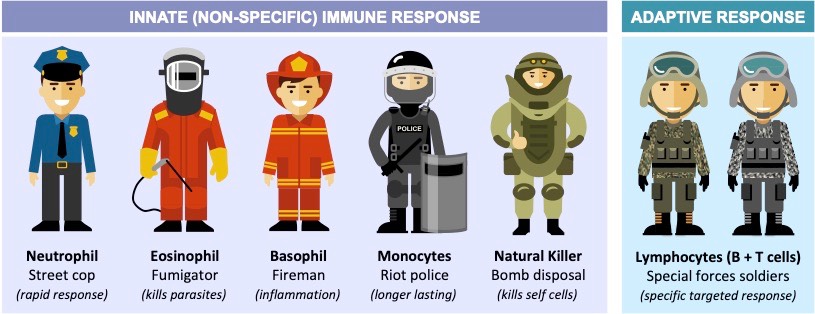Key Knowledge:
|
Once a pathogen has evaded the surface barriers comprising the first line of defence, it is challenged by white blood cells (leukocytes)
- There are three main types of white blood cells that function within the human body – granulocytes, monocytes and lymphocytes

Innate Immune Cells
Leukocytes that function non-specifically to remove pathogens from the host body are considered part of the innate immune system
- These cells include neutrophils, eosinophils, mast cells / basophils, monocytes (macrophages / dendritic cells) and NK cells
Neutrophils
- Neutrophils are the most abundant type of white blood cell and the first responder to microbial infection
- They are very short-lived and have a circulating life span of less than a day (forms the majority of pus)
- Neutrophils destroy pathogens via phagocytosis but are not involved in subsequent antigen presentation
- Analogy: Standard police officer – quick to respond to the situation, but lacks special training or skills and so dies rapidly
Eosinophils
- Prominent at the sites of allergic reactions and parasitic infections (rare in blood but common at mucous membranes)
- Do not phagocytose pathogens but instead release chemical products which perforate cell membranes
- Consequently, they function as the primary response to large multicellular parasites (e.g. helminth infections)
- Analogy: Fumigator – specialised to deal with pests / parasites (e.g. helminths) by releasing chemical products
Mast Cells / Basophils
- These cells are chiefly responsible for initiating inflammatory responses by releasing the chemicals histamine and heparin
- Mast cells and basophils are functionally similar, however mast cells are localised while basophils circulate in the blood
- Because they promote inflammation, they are common contributors to allergic responses
- Analogy: Fireman – the leukocyte involved when a region is inflamed (‘in flames’)
Monocytes
- Monocytes are the largest type of leukocyte and share phagocytosis duties with neutrophils
- They are slower to respond than neutrophils but are longer lasting, as they can renew their lysosomes for continued digestion
- The are responsible for antigen presentation (to lymphocytes) and serve as a link between the innate and adaptive systems
- Monocytes will differentiate into two types of cells in response to pathogenic infection – macrophages and dendritic cells
- Macrophages typically remain in the tissue and phagocytose, whereas dendritic cells are better suited to antigen presentation
- Analogy: Riot police – slower to respond than standard police but better prepared and survives for longer
Natural Killer (NK) Cells
- Natural killer cells function to target and destroy virally infected or cancerous body cells (i.e. they target ’self’ tissue)
- They are a type of lymphocyte and have a comparable role to cytotoxic T cells, except that they are non-specific in function
- NK cells are recruited to sites of infection when the infected cells release a specific chemical agent (cytokine) called interferon
- Analogy: Bomb disposal technician – functions to remove suspicious or compromised cells from within the body
Adaptive Immune Cells
Leukocytes that function specifically to remove pathogens from the host body are considered part of the adaptive immune system
- These cells include both B and T lymphocytes (TH and TC cells), but do not include natural killer cells (which are non-specific)
Lymphocytes
- These cells are more common in the lymphatic system than blood and are slowest to respond (requiring antigen presentation)
- Helper T cells (TH cells) release chemical agents called cytokines to stimulate an antigen-specific B lymphocyte to form clones
- B lymphocytes divide and differentiate into antibody-secreting plasma cells to destroy extracellular pathogens (humoral immunity)
- Cytotoxic T cells (TC cells) specifically target intracellular pathogens – virally infected or cancerous cells (cell-mediated immunity)
- Analogy: Special forces troops – takes longest to mobilise but specially trained to target specific pathogens
